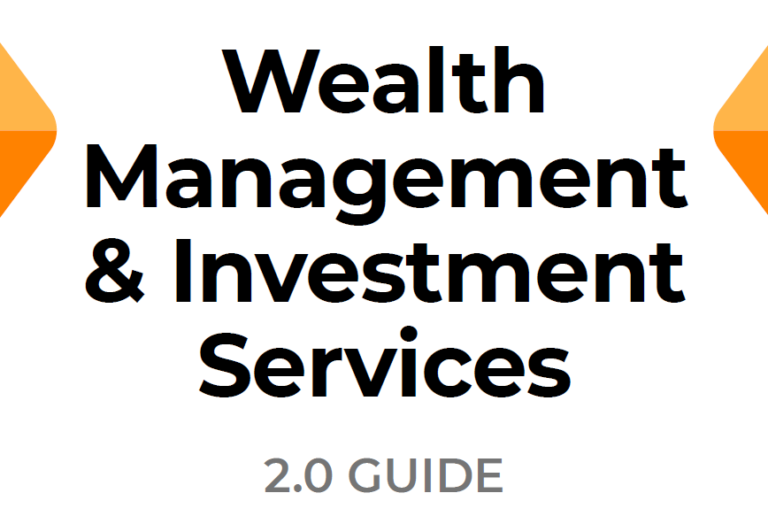This 2.0 Guide is intended to show the state of investment services providers and how they help credit unions provide wealth-building options for their members. It should also offer some perspective about why digital investment platforms are necessary for credit unions to compete with fintech and big bank providers.
Wealth management now comes in many forms, including retirement, children’s accounts, robo-advisors, digital brokerages, cryptocurrency exchanges, and traditional wealth management advising. For the purposes of this guide, we’ll avoid wealth management solutions that focus on retirement, UTMA/UGMA accounts, and other solutions that don’t appeal to retail investors.
Also for the purposes of this guide, we will not provide an exhaustive list of competitors—competitors shown are for illustrative purposes only. Nevertheless, it’s important to note how many competitors are included in this guide—this should indicate how much competition is out there for these member deposits.
Credit unions can work with fintechs and CUSOs to establish or expand their investment offerings. Investment services and wealth management are particular areas of emphasis for CU 2.0, as we believe that this is a critical product angle for engaging younger members with disposable cash. Read on to learn more.
Investment Services Trends and Statistics
Nearly 90% of Millennials invest their money.
Due to long-term economic conditions, Gen Z is well positioned to have more disposable income than Millennials. That means that, statistically, 9 of every 10 members under 41 invest their money… and probably not with your credit union.
Currently, fintechs dominate the investment space. Traditional giants like Vanguard and TD Ameritrade have far fewer young investors than new players like Robinhood and Acorns.
Limited options from traditional financial institutions.
Surveys show that most Americans would prefer to invest with their primary financial institution. However, only 0.5% of members invest with their credit union. Most members invest outside of the credit union. They have 401ks and IRAs from employers. They have wealth managers and brokers. And, more commonly, they invest on their own, thanks to fintechs.
While large banks are doing their best to provide investment services to more of their members, they’re clearly in reaction mode, taking cues from leading fintech investment platforms (i.e. removing trading fees a la Robinhood).
Credit unions offer far fewer options and, unfortunately, lag behind banks. So, despite the demand for investment services, and despite a general stated preference to invest with their primary financial institution, credit unions haven’t given their members the option.
3x more engagement.
After offering a digital investment option, credit unions see roughly 3 times more logins per month for each member that uses the investment product.
There are few better ways to deepen your relationship with a member than providing a new product that also maximizes touchpoints and interactions with your credit union.
Keeping money in the credit union.
Investment services aren’t just a potential revenue stream for your credit union—they’re an assurance that competitors don’t siphon all your members’ deposits into their ecosystem.
If you track all the money leaving your credit union that goes to competitor investment products each month, you’ll see how much you stand to lose. While we’d usually highlight the potential income from investments, the income potential changes depending on which partner you work with. The amount of money that stays in your credit union will be a much higher number anyway.
Digital is the way.
Digital means convenience and ease of use. It means not making appointments, scheduling phone calls, or leaving the comfort of one’s own home.
The fintechs that now dominate for Millennial and Gen Z investors are all digital. Users can buy, sell, reconfigure, and otherwise manage their entire portfolios instantly on any device.
To realistically capture a share of the market for investors under 50, credit unions must prioritize digital-first investment and wealth management solutions.
Wealth Management and Investment Services Evaluation Strategies
Not all investment services products work the same way. Some target investors who’d rather set it and forget it, others support investors who prefer self-directed investing, and some offer managed portfolios with traditional live advisors.
These are a few types of investment products features you may want to consider when evaluating potential partners:
Robo-advisors
Does the solution allow users to automatically allocate, balance, and manage money without directly involving a financial advisor?
Digital brokerage
Can the platform allow users to buy, sell, and manage a self-directed portfolio of stocks, bonds, ETFs, and more?
Wealth management
Does the provider give your members personalized investment advice or financial guidance? Will they fully manage your members’ investment portfolios?
Deposits
Can the solution incentivize higher deposits? Does it ensure that members can build a balanced financial picture for themselves?
Debt repayment
Can the provider help members pay off debts? Can members use the service to pay down student loans, credit card debt, etc.?
Retirement
Does the solution provide options for retirement saving? Can members access investment and retirement information from the same account screen?
Investing for children
Does the solution allow parents to set up investment accounts for their children (such as UGMA and UTMA accounts)?
Buy Now, Pay Later Fintech Ratings
Rating Methodology
CU 2.0’s rating methodology for our early guides is very simple. We measure the potential impact of working with each fintech on three variables: Member Impact (services offered, ease of use, etc.), Credit Union Impact (product mix and fit, income/ROI, etc.) and Product Type (Robo-advisor, brokerage, wealth management, other).
Ratings are shown on a 0–3 scale.
0: N/A or no impact. Competes with or disintermediates credit unions; doesn’t offer relevant services.
1: Minimal impact. Limited partnership opportunities; limited or narrow target audience.
2: Moderate impact. Partners with credit unions but may require more resources; meets at least one or several common investment needs.
3: Major impact. Partners well with credit unions and doesn’t require much resource or investment; offers several investment services and features clear, measurable ROI.
Our impact ratings don’t necessarily correlate to the quality of a given solution. Fintechs with higher potential impact scores aren’t automatically better, or a better fit, for your credit union and members.
Fintech Ratings
The following fintechs are listed alphabetically. These ratings correspond only to the three listed variables (Member Impact, Credit Union Impact, and Product Type). These aren’t ranking of quality, nor are they recommendations—they’re meant only to serve as a starting point in your research to improve your credit union’s wealth management and investment services strategy.
Trusted solutions are highlighted with an asterisk—these are fintechs that CU 2.0 has vetted personally.
Wealth Management and Investment Services Providers
| Fintech | Description | Member Impact | CU Impact | Type | |||
| Acorns | Acorns is a robo-advisor that rounds up spare change from purchases and invests it in a risk-appropriate portfolio. They now offer IRAs, checking accounts, and UGMA/UTMA accounts as well. | 3 | 0 | Robo-advisor | |||
| BestVest Investments, LLC | BestVest Investments helps credit unions implement a member financial services solution with a massive array of investment and insurance options, but their digital offering isn’t as clean or convenient (read: sophisticated) as most competitors on this list. | 2 | 2 | Other | |||
| Betterment | Betterment is a robo-advisor with good customization options and goal-based tools. And, because there’s no account minimum, it’s easy for anyone to get started. | 2 | 0 | Robo-advisor | |||
| Changed | Changed rounds up spare change from transactions and uses it to pay down user debt (mortgage, student, auto, etc.) or increase savings. | 1 | 2 | Other | |||
| Credit Union Wealth Group | Credit Union Wealth Group provides turnkey financial planning, wealth management, a robo-advisor, brokerage, and even managed crypto investments. | 3 | 3 | Wealth management, robo-advisor, brokerage | |||
| CUSO Financial Services | CUSO Financial Services and Sorrento Pacific Financial work with credit unions and banks to provide wealth management with investment services and digital offerings. | 3 | 2 | Wealth management | |||
| Eko | Eko is a robo-advisor and digital investment platform that allows credit unions to offer balanced, customizable, and competitive portfolios through their existing online and mobile banking. | 3 | 3 | Robo-advisor, brokerage | |||
| E*TRADE | Morgan Stanley’s E*TRADE caters to digital-first investors with a variety of stocks, bonds, and more. | 2 | 0 | Brokerage | |||
| Morgan Stanley | Morgan Stanley is a traditional wealth management provider with a wide variety of wealth building and management options, with emphasis on individual and in-person financial advisory. | 3 | 0 | Wealth management | |||
| Robinhood | Robinhood is a digital brokerage and investment app that pioneered free trades and a simple user interface. Users can purchase fractions of stock, buy and send crypto, and create a spending account with rewards. | 3 | 0 | Brokerage, other | |||
| SoFi | SoFi debuted a new robo-advisor with limited automated investing options, but they will likely expand quickly. | 1 | 0 | Robo-advisor | |||
| Unifimoney | Unifimoney offers both a robo-advisor and digital investment platform that also offers digital asset trading (yep, crypto) through their financial services-friendly platform. | 3 | 3 | Robo-advisor, brokerage | |||
| Vanguard | Vanguard is a robo-advisor with relatively few portfolio options and limited customizability, but they have strong expertise and a fantastic track record. | 1 | 0 | Robo-advisor | |||
| Wealthfront | Wealthfront is a robo-advisor that rebalances and does tax-loss harvesting daily, thus optimizing portfolios more often than most robo-advisors. | 1 | 0 | Robo-advisor | |||
| Webull | Webull is a digital brokerage and investment app that provides a similar experience to Robinhood, but with more sophisticated options that support intermediate and advanced traders better. | 2 | 0 | Brokerage | |||
Please note that these ratings are in their early stages and will be updated as we include more data and more complex variables. The ratings are not definite—your credit union could see a different level of impact than listed in this guide.
Did we miss a fintech? Please let us know at info@cu-2.com
Recommendations
Choosing the right partner will depend on your goals, budget, timeline, and other factors. The shop that works for the credit union down the street may not be the best fit for you.
For deeper discussion, analysis, and recommendations, CU 2.0 can help in the following ways:
- Join our Fintech Call Program. In quarterly 30-minute calls, we’ll discuss in depth new and innovative fintech solutions that fit your credit union’s needs. We can also help you review other solutions you’re looking at.
- Ask for an introduction. We maintain relationships with most or all of the vendors rated above. We would be happy to give you a warm introduction to any we can on the list.
- Book a consultation. CU 2.0 offers technology and fintech consultations and reviews to identify best-fit solutions for your credit union.




